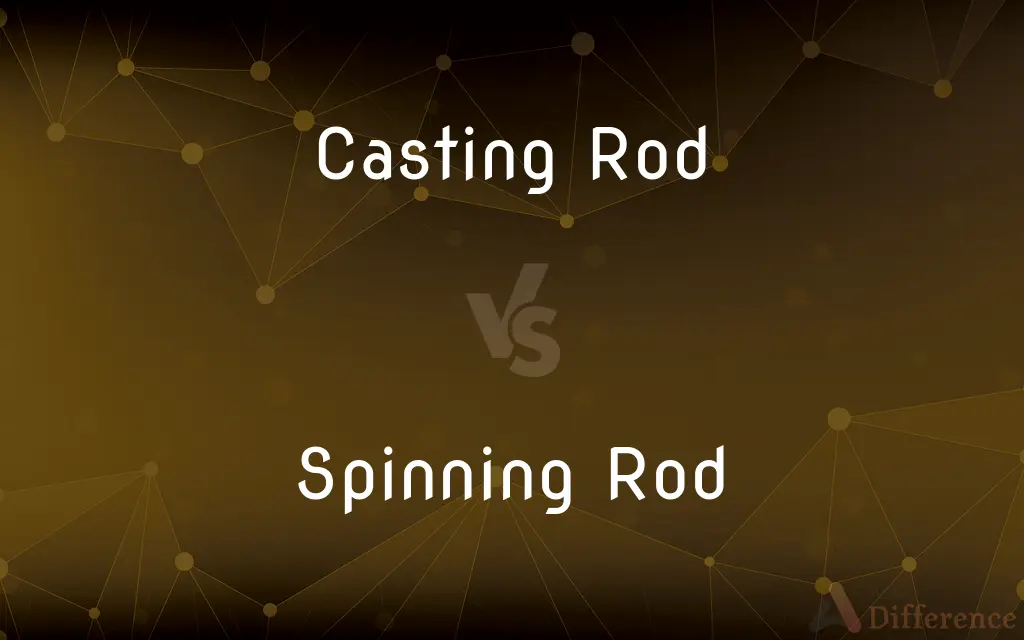Casting Rod vs. Spinning Rod — What's the Difference?
By Urooj Arif & Maham Liaqat — Published on March 1, 2024
A casting rod is designed for precision and control, featuring a trigger grip and guides on top, suited for baitcasting reels. Spinning rods, on the other hand, are easier to use, with larger guides and a bottom-facing reel seat, ideal for spinning reels.

Difference Between Casting Rod and Spinning Rod
Table of Contents
ADVERTISEMENT
Key Differences
Casting rods are engineered for accuracy and are typically used by more experienced anglers. The guides on a casting rod face upwards (towards the angler), which helps in handling heavier lines and lures, making them suitable for targeting larger fish. Spinning rods offer ease of use and versatility, especially for beginners. Their guides face downwards, reducing the likelihood of line tangling, and they work well with lighter lures and baits.
Spinning rods are generally more forgiving when casting, allowing for a smoother and longer cast with less effort. This characteristic makes them particularly favored for fishing techniques that require finesse, such as using live bait or lightweight lures. Casting rods, by contrast, provide the angler with greater control over the bait's presentation, especially important in techniques like flipping or pitching where precision is key.
The reel seat on casting rods is designed to hold a baitcasting reel above the rod, which allows for a direct transfer of power and sensitivity from the rod to the angler's hands. Spinning rods have the reel seat below the rod, accommodating spinning reels, which can be easier for beginners to manage due to their open-face design and ease of casting.
Another distinction lies in the types of fishing each rod is best suited for. Casting rods are often preferred for bass fishing and other scenarios where precise lure placement is crucial. Spinning rods, with their ability to handle lighter lines and lures, are excellent for a wide range of fishing styles, including freshwater and saltwater fishing.
In terms of physical design, casting rods usually feature a trigger grip, which provides a stable hold for casting and retrieving, enhancing the angler's control. Spinning rods lack this feature since the reel's position naturally balances the rod in the angler's hand, offering comfortable use over extended periods.
ADVERTISEMENT
Comparison Chart
Guides Orientation
Upwards (towards the angler)
Downwards (away from the angler)
Reel Seat Position
Above the rod
Below the rod
Ease of Use
Best for experienced anglers
Ideal for beginners and versatile fishing
Preferred Technique
Precision casting and control
Finesse fishing with lighter lures
Trigger Grip
Yes
No
Compare with Definitions
Casting Rod
Features guides on top of the rod.
The casting rod's upward-facing guides support heavy line tension.
Spinning Rod
They accommodate spinning reels underneath the rod.
Attaching a spinning reel to the rod was straightforward for the beginner.
Casting Rod
Often includes a trigger grip.
The casting rod's trigger grip helped him maintain a firm hold during the cast.
Spinning Rod
Ideal for finesse fishing techniques.
Using a spinning rod, he mastered the art of finesse fishing.
Casting Rod
Casting rods are designed for precision and control in fishing.
He used a casting rod for accurate lure placement near the lily pads.
Spinning Rod
Features larger guides facing downwards.
The spinning rod's large guides facilitated smooth line release.
Casting Rod
They are compatible with baitcasting reels.
Mounting a baitcasting reel on a casting rod enhances casting accuracy.
Spinning Rod
Spinning rods are user-friendly, perfect for all skill levels.
She chose a spinning rod for her first fishing trip.
Casting Rod
Suited for targeting larger fish.
For the big bass in the lake, he preferred his trusted casting rod.
Spinning Rod
Versatile for freshwater and saltwater fishing.
His spinning rod was versatile enough for both the river and the sea.
Common Curiosities
Can beginners use casting rods?
Beginners can use casting rods, but they may find spinning rods easier to learn due to their straightforward casting mechanism.
What is a spinning rod?
A spinning rod is versatile and user-friendly, designed to work with spinning reels, ideal for beginners and finesse fishing.
What is a casting rod?
A casting rod is designed for fishing with precision, using baitcasting reels and techniques that require accurate lure placement.
Why choose a casting rod over a spinning rod?
Choose a casting rod for more control and precision in casting, especially when targeting larger fish or specific locations.
Are spinning rods suitable for all types of fishing?
Spinning rods are highly versatile, suitable for various fishing techniques, including both freshwater and saltwater environments.
Can I use heavy lures with a spinning rod?
While spinning rods can handle a range of lure weights, they are generally better suited for lighter lures compared to casting rods.
Are there different sizes of casting and spinning rods?
Yes, both casting and spinning rods come in various lengths and power ratings to suit different fishing conditions and target species.
Why do experienced anglers prefer casting rods?
Experienced anglers value the control and precision that casting rods offer, particularly for techniques requiring accurate lure placement.
What makes spinning rods easier to use?
The design of spinning rods, including the placement of the reel and the orientation of the guides, makes them more forgiving and easier to handle, especially for novices.
What is the benefit of a trigger grip on a casting rod?
The trigger grip provides extra stability and control during casting and retrieval, enhancing the angler's precision.
Can casting rods use spinning reels?
Casting rods are specifically designed for baitcasting reels, and using a spinning reel with them is not practical due to the mismatch in design and function.
What types of water are best for spinning rods?
Spinning rods are adaptable for both moving and still waters, making them suitable for streams, lakes, and coastal fishing.
How do I choose between a casting and spinning rod?
Consider your experience level, the fishing technique you plan to use, and the type of fish you're targeting to decide between the two.
Is one type of rod more expensive than the other?
Pricing can vary based on brand, quality, and features rather than the type of rod itself. Both casting and spinning rods have a wide price range.
Do casting rods require more maintenance than spinning rods?
Maintenance requirements are similar for both types of rods, focusing on cleaning and caring for the guides, reel seat, and handling to ensure longevity.
Share Your Discovery

Previous Comparison
Jade vs. Serpentine
Next Comparison
Fat Soluble Vitamins vs. Water Soluble VitaminsAuthor Spotlight
Written by
Urooj ArifUrooj is a skilled content writer at Ask Difference, known for her exceptional ability to simplify complex topics into engaging and informative content. With a passion for research and a flair for clear, concise writing, she consistently delivers articles that resonate with our diverse audience.
Co-written by
Maham Liaqat















































